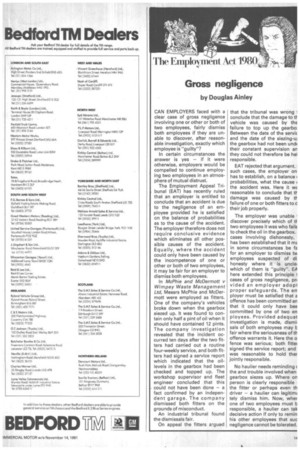Gross negligence
Page 83

If you've noticed an error in this article please click here to report it so we can fix it.
by Douglas Ainley
CAN EMPLOYERS faced with a clear case of gross negligence involving one or other or both of two employees, fairly dismiss both employees if they are unable to discover, after reasonable investigation, exactly which employee is "guilty"?
In certain circumstances the answer is yes — if it were otherwise, employers would be compelled to continue employing two employees in an atmosphere of mutual distrust.
The Employment Appeal Tribunal (EAT) has recently ruled that an employer is entitled to conclude that an accident is due to the negligence of an employee provided he is satisfied on the balance of probabilities as to the cause of the accident. The employer therefore does not require conclusive evidence which eliminates all other possible causes of the accident. Equally, where the accident could only have been caused by the incompetence of one or other or both of two employees, it may be fair for an employer to dismiss both employees.
In McPhie and McDermott v Wimpey Waste Management Ltd, Messrs McPhie and McDermott were employed as fitters. One of the company's vehicles broke down when the gearbox siezed up. It was found to contain only half a pint of oil when it should have contained 12 pints. The company investigation revealed that the incident occurred ten days after the two fitters had carried out a routine four-weekly service, and both fitters had signed a service report which indicated that the oillevels in the gearbox had been checked and topped up. The workshop supervisor and fleet engineer concluded that this could not have been done — a fact confirmed by an independent garage. The company dismissed both fitters on the grounds of misconduct.
An industrial tribunal found the dismissals fair.
On appeal the fitters argued
that the tribunal was wrong 1 conclude that the damage to tF vehicle was caused by the failure to top up the gearbo; Between the date of the servic and the date of the siezing-ul the gearbox had not been undo their constant supervision an they could not therefore be hel responsible.
EAT rejected that argument. such cases, the employer on has to establish, on a balance probabilities, what the cause the accident was. Here it %on reasonable to conclude that th damage was caused by tifailure of one or both fitters to d their job properly.
The employer was unable discover precisely which of two employees it was who fail( to check the oil in the gearbox. cases involving dishonesty, has been established that it mi in some circumstances be fa for an employer to dismiss tvt employees suspected of di honesty where it is unclei which of them is "guilty". EP here extended this principle 1 cases of gross negligence, pro vided an employer adopi proper safeguards. The err player must be satisfied that a offence has been committed an that it could only have bee committed by one of two en ployees. Provided adequat investigation is made, dismi: sals of both employees may b fair where the seriousness of th offence warrants it. Here the o fence was serious; both fitteo signed the service report; and was reasonable to hold ther jointly responsible.
No haulier needs reminding the and trouble involved when gearbox siezes up. Where on person is clearly responsible • the fitter or perhaps even th driver — a haulier can legitirm tely dismiss him. Now, whet one of two employees must b responsible, a haulier can tak decisive action if only to remin his other employees that suc negligence cannot be tolerated.






















































































